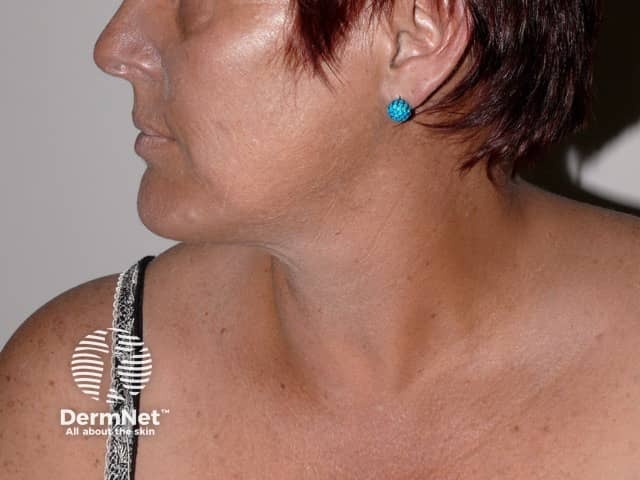Main menu
Common skin conditions

NEWS
Join DermNet PRO
Read more
Quick links
Author: Paula Barlow, Medical Oncology Registrar, Capital and Coast District Health Board, Wellington, New Zealand, September 2016.
Introduction Demographics Causes Clinical features Diagnosis Treatment Outcome
Diffuse melanosis cutis is a rare presentation of metastatic melanoma in which the entire skin surface changes colour.
Diffuse melanosis cutis is predicted to occur in around 1–2% of cases of metastatic melanoma.
The exact pathophysiology underlying diffuse melanosis cutis is not well established. One theory is that it is caused by circulating melanin precursors released by melanoma cells, which enter the dermis and undergo auto-oxidation to melanin within dermal histiocytes and dermal extracellular fluid.
Diffuse melanosis cutis presents as progressive blue-grey discolouration of the entire skin and mucous membranes that typically occurs over weeks to months. It is also often associated with melanuria — darkening of the urine — which becomes more pronounced as the urine stands.

Diffuse melanosis cutis

Diffuse melanosis cutis
There are no specific diagnostic criteria for diffuse melanosis cutis. It is generally diagnosed in the context of a patient with known melanoma. Skin biopsy generally reveals melanin pigment within dermal histiocytes and free pigment within the connective tissue. The epidermis is usually unremarkable.
Other causes of discolouration of the skin, such as jaundice, acanthosis nigricans, and Addison disease should be excluded.
Treatment of diffuse melanosis cutis involves treating the underlying melanoma. There have been no reports of diffuse melanosis cutis reversing.
A number of case reports have described promising responses to molecularly targeted therapies (eg vemurafenib, dabrafenib, trematinib) and immune checkpoint inhibitor therapy (eg pembrolizumab, nivolumab) in patients with diffuse melanosis cutis.
Historically, patients with diffuse melanosis cutis have had a very poor prognosis, with one review finding the mean time from onset of diffuse melanosis cutis to death to be 4.4 months.
It is hoped that the new treatments now available for metastatic melanoma will improve outcomes.